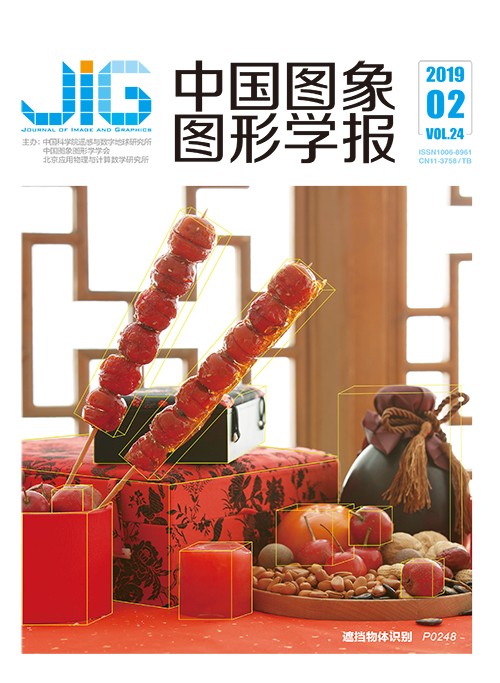
混合先验与加权引导滤波的图像去雾算法
摘 要
目的 图像去雾是降低雾、霾、沙等低能见度成像环境对图像的退化影响,提高图像信息获取质量的过程。为了消除先验盲区,同时进一步提高去雾图像边缘细节的清晰度,提出一种混合先验与加权引导滤波的图像去雾算法。方法 首先改进大气光值估计方法,提高大气光值估计的准确性。然后利用混合先验理论求取双约束区域的大气透射率,一定程度上消除了先验盲区,提高了去雾算法的鲁棒性。最后利用加权引导滤波算法优化透射率图,提高了图像边缘细节的清晰度。结果 本文以通用去雾测试图像和小型无人机拍摄的雾天图像作为实验对象,通过对比分析4种组合步骤算法的复原效果,验证本文各步骤改进方法的合理性与整体算法的优越性。实验结果表明:混合先验理论改善了暗原色先验在明亮区域的失真现象和颜色衰减先验对浓雾处理上的不足,取得了较好的视觉效果;加权引导滤波改善了图像边缘模糊的现象,使复原后的图像边缘细节更加清晰;相较传统算法,本文算法视觉效果更好,去雾图像边缘细节更加明显,综合评价指标均值提升幅度较大。结论 针对有雾图像复原,通过理论分析和实验验证,说明了本文各步骤的改进具有一定的优越性,所提的算法具有较强的鲁棒性。
关键词
Mixed prior and weighted guided filter image dehazing algorithm
Li Zhe, Li Jianzeng, Hu Yongjiang, Zhang Yan(Department of UAV Engineering, Army Engineering University, Shijiazhuang 050003, China) Abstract
Objective Image dehazing is a process of reducing the degradation effect of low-visibility imaging environment, such as fog, sputum, and sand, and improving the quality of image information acquisition. Image dehazing mainly solves the problems of image feature information blur, low contrast, gray-level concentration, and color distortion. At present, image dehazing methods are mainly divided into two categories, namely, image restoration and image enhancement. A dehazing algorithm based on image restoration is used to establish a physical model of image degradation in restoring the clear image in a targeted manner by analyzing the degradation mechanism of the image and by using prior knowledge or assumptions. The dehazing algorithm is more targeted compared with image enhancement algorithms. Deblurring is better and image information is complete, which should be investigated. Therefore, an image dehazing algorithm based on mixed prior and weighted guided filter (MPWGF) is proposed to eliminate the prior blind zone and improve the sharpness of the edge detail of haze-free images. Method First, a new method of atmospheric light value estimation is proposed to reduce the limitation of atmospheric light value estimation and utilize the advantage of mixed prior conditions. Pixel positions of 0.1% before brightness in dark channel and depth maps are extracted, and coordinate points extracted from the two images are compared. The coordinate points are retained when two images are observed simultaneously; otherwise, the values with the highest brightness that correspond to the remaining coordinate points in the original image are eliminated. This method can eliminate outliers to some extent and improves the accuracy of atmospheric light estimation. Then, mixed prior theory is used to calculate the atmospheric transmission of the double-constraint region, which eliminates the prior blind zone to a certain extent. This theory improves the robustness of the dehazing algorithm. The dark channel prior (DCP) and color attenuation prior (CAP) have good recovery effects and can compensate for the existence of the prior blind zone. Therefore, an effective region segmentation method is proposed to segment the bright and foggy regions of blurred images. On the basis of regional characteristics, DCP and CAP are used to obtain atmospheric transmittance maps to solve the prior blind region problem in which a single prior estimation method affects the robustness of the restoration algorithm. Finally, an adaptive guided filter algorithm is used to optimize the transmission map, which improves the sharpness of the image edge details. The obtained coarse transmittance map should be refined to eliminate the halo and block artifacts that locally exist in the restored image. A traditional transmittance map optimization algorithm has poor edge retention capability and serious loss of details. Thus, this study proposes an adaptive weighted guidance filtering algorithm based on the traditional algorithm. The edge detail improvement of the fine transmittance map is achieved by adding an adaptive weighted factor. Result In this study, the general dehazing test image and foggy image captured by a small UAV are taken as experimental objects. The rationality of the improved methods and the superiority of the overall algorithm are verified by comparing and analyzing the restoration effects of the four combined step algorithms. Experimental results show that the mixed prior theory improves the distortion of the dark priori in the bright region and the deficiency of CAP in dense fog processing and achieves better visual effect. Weighted guided filtering improves the image edge blurring and makes the image edge details clear after restoration. In comparison with other comparison algorithms, the proposed method has better visual effects, and the edge details of haze-free images are more evident. The average increase of comprehensive evaluation index is large. Conclusion For the restoration of hazy images, the superiority of the proposed improved model is demonstrated through theoretical analysis and experimental verification. The restoration of the proposed algorithm is better than that with the traditional algorithm. The main conclusions are summarized as follows. Mixed prior theory can improve the prior blind area problem in DCP and CAP theories to a certain extent, and the effect of image defogging is better. The adaptive guided filtering algorithm can optimize the transmittance image better and improve the edge sharpness of the defogging image. The image defogging effect can be improved by combining hybrid prior theory with the adaptive guided filtering algorithm. Under the same conditions, the proposed algorithm has better image restoration effect compared with the traditional fog removal algorithm. In this study, several limitations are observed in the parameter setting of regional segmentation, such as the adjustment of parameters through experience and insufficient certain theoretical basis. The parameter setting will be investigated in our future study. MPWGF has broad application prospects in image restoration, artificial intelligence, photogrammetry, and other fields.
Keywords
|



 中国图象图形学报 │ 京ICP备05080539号-4 │ 本系统由
中国图象图形学报 │ 京ICP备05080539号-4 │ 本系统由